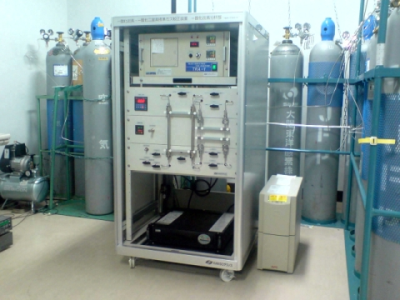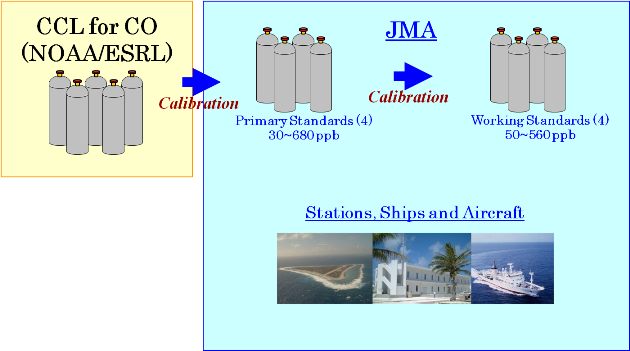Calibration for atmospheric carbon monoxide observation
JMA operates a carbon monoxide (CO) calibration system to maintain CO standard gases in two ranks.
JMA standard gases
JMA primary standard gases
In the first rank of gases on which JMA's CO observations are based, the primary standard gases for CO are stored in four cylinders with concentrations ranging from around 30 to 680 ppb. The cylinders used to store the gases, which are mixtures of CO and natural air, have a volume of 48 liters and are made of aluminum alloy to minimize drift. The concentrations of the primary gases were determined accurately against the WMO reference standard gases maintained by NOAA/ESRL in March 2010 (Novelli et al. 1994) . The standard scale is called WMO CO, and assures the international traceability of JMA's observations.
JMA working standard gases
The concentrations of the four working standard gases used at observation stations and on aircraft are determined using the CO calibration system at JMA Headquarters based on the primary standard gases, and these working standard gases are then sent out to individual stations. After use in observation, the gases are sent back to JMA Headquarters to be checked for drift, and the concentrations are compared with those of the primary standard gases (see Atmospheric carbon monoxide observation ) .
Calibration system
The calibration system for CO concentration is configured using a gas chromatograph analyzer with a reduction gas detector (GC-RGD: Round Science Inc. TRA-1) . The repeatability of the CO calibration system does not exceed 3 ppb, which is determined by introducing standard gases ten times and taking the standard deviation for the mean peak area.
|
Figure 1: CO calibration system at JMA headquarters |
|
Figure 2: JMA Calibration architecture for CO standard gases |
References
Novelli, P. C., K. A. Masarie, P. M. Lang, B. D. Hall, R. C. Myers, and J. W. Elkins, 2003: Reanalysis of tropospheric CO trends: Effects of the 1997-1998 wildfires. J. Geophys. Res., 108 (D15) , 4464, doi:10.1029/2002JD003031.

